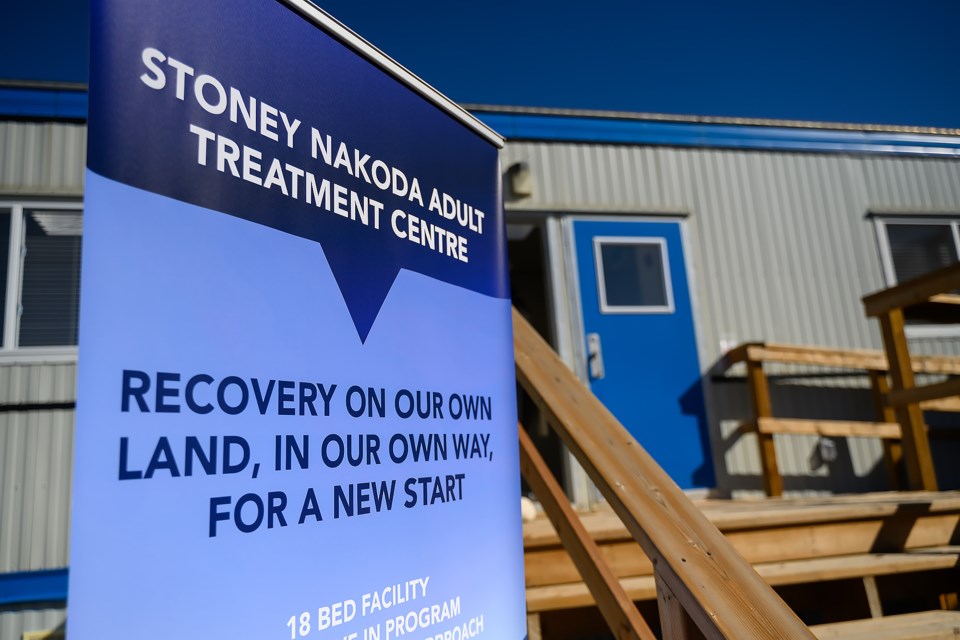ÎYÂRHE NAKODA – The Stoney Nakoda Treatment Centre is ready to welcome residents seeking substance abuse recovery and culturally-centred healing at its 18-bed facility.
The long-awaited Stoney Health Services-run treatment centre in Mînî Thnî, which officially opened Thursday (Oct. 5), has been offering a day program since June. Anticipating the finished facility passes inspection by Alberta Health Services next week, it can receive final licencing to run its 90-day residence treatment program.
“I’m beyond happy that we’re finally able to have a treatment centre here now for the community and for people to be able to get that care without having to leave their home community,” said Skilee Dixon, manager of the treatment centre.
The facility’s programming was informed by community feedback at information sessions facilitated by the local health authority in March and April.
“My biggest thing was to make the community feel heard, to make them feel acknowledged and ensure they know their voice was going to be part of what we do,” said Dixon. “The majority said our programs need to be culturally appropriate and incorporate our language, ceremony and traditions, so that’s what we’re doing.”
In August, one of Îyârhe Nakoda Nations’ three chiefs, Bearspaw Chief Darcy Dixon called attention to the number of deaths recorded among band members in 2022. In a letter to Indigenous Services Canada, the chief reported 28 deaths among Bearspaw’s 2,000 members due primarily to opioid poisoning.
According to the chief’s statistics, which are recorded as unofficial internal numbers, all three of the Nations, including Goodstoney and Chiniki, had 58 deaths in 2021, 72 in 2020, 43 in 2019, and 35 in 2018 – most of which were due to overdose or related to substance abuse.
A toxic drug supply circulating the Nation in May claimed the lives of three people over two days, RCMP confirmed. Deaths connected to the deadly drugs – believed to be laced with the powerful sedative Xylazine – prompted a public warning from local emergency services at the time.
All three chiefs, treatment centre staff and Mental Health and Addictions Minister Dan Williams were in attendance for the treatment centre’s grand opening to speak about the impacts of addiction and the importance of recovery.
Williams acknowledged it takes access to appropriate recovery facilities and programs so community members are “able to be chiefs, able to be elders able to impart their wisdom, able to raise families [and] able to be a living, breathing part of [the] community.”
Duane Wesley, a peer support counsellor with the treatment centre, said 36 people have accessed the facility’s day program since it opened June 5.
“Some have completed the program; and some start it, go away and come back. But it doesn’t matter if you miss a session. We keep it very open to everybody and we’ve had some good outcomes,” said Wesley.
In addition to ceremony, programming also includes nutrition and tapping into traditional harvest practices.
“Our people used to and still do to this day harvest vegetation that helps them on their healing journey,” said Wesley. “A lot of clients are amazed and surprised that these harvestables are just right out their back door.”
These teachings are often delivered by elders and knowledge keepers, who play a vital role in ensuring traditional knowledge is passed down in the community.
Skilee Dixon said she is pleased with what the treatment centre has been able to achieve so far, but that she also looks forward to expanding its programming into a bigger, better facility “that we deserve.”
According to the latest opioid surveillance report from December 2021 on First Nations people in the province, First Nations people represented about six per cent of the Alberta population, yet they represented 22 per cent of all opioid poisoning deaths in 2020, an increase from 14 per cent in 2016.
This year, when opioid EMS calls spiked to record highs, according to Alberta Health Services data, the province announced it was partnering with First Nations to build recovery communities – a form of long-term treatment – on Siksika Nation, Tsuut’ina Nation, Enoch Cree Nation and Blood Tribe lands.
However, no such support was announced for Îyârhe Nakoda First Nation and other Indigenous communities grappling with drug crises.
The Mînî Thnî treatment centre is also lacking in operational support, said Dixon.
“We’re using our own dollars to be able to get what we need and to start rolling out and launching the program,” she said. “One hundred per cent I would love to see us get the treatment centre we deserve and we’re trying to get funding from possibly the federal and provincial government.
“Maybe then this space could become an aftercare facility, or something that meets another need in the community, so we’re able to build and support that whole continuum of recovery.”
The Local Journalism Initiative is funded by the Government of Canada. The position covers Îyârhe (Stoney) Nakoda First Nation and Kananaskis Country.




